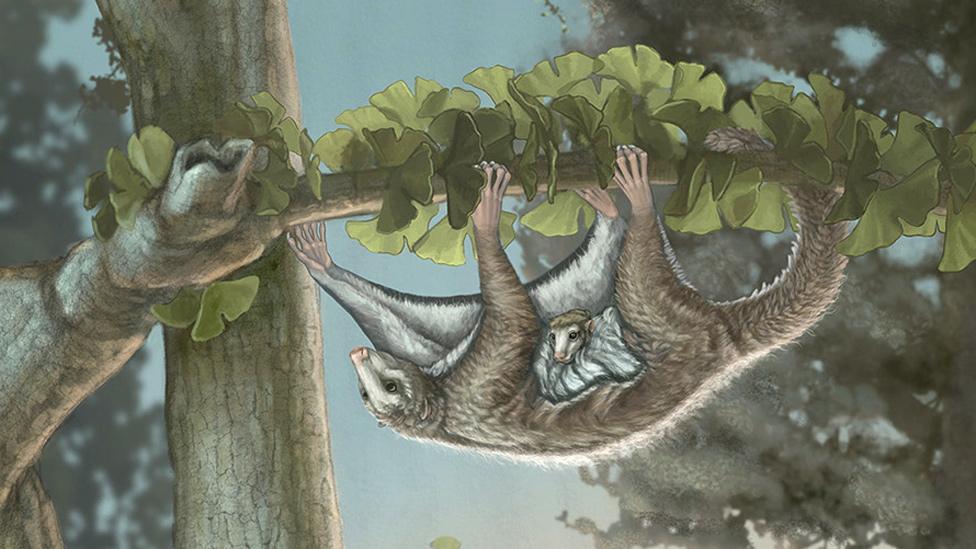First 'winged' mammals flew over dinosaurs
- Published

The new species of winged-mammal Maiopatagium in a Jurassic forest
Fossils of the first "winged" mammals, from 160 million years ago, have been discovered in China.
They reveal that mammal ancestors evolved to glide between trees in a similar way to some mammals today.
This adds to evidence that mammals were more diverse during the age of dinosaurs than previously realised.
The work is published by an international team of scientists .
The two new fossil species exhibit highly specialised characteristics, including adaptations that allowed them to climb trees, roost on branches and glide.
This means that the ability of mammals to glide evolved much earlier than previously thought. Prof Zhe-Xi Luo, from the University of Chicago, US, said: "These Jurassic mammals are truly the first to glide.
"In a way, they got the first 'wings' among all mammals," he told 大象传媒 News.
The wings are the preserved remains of a skin membrane that stretches, parachute-like, between fore and hind limbs, allowing the creatures to glide.
Maiopatagium looked similar to today's flying squirrels
The evidence of this volant, or flying, lifestyle in these fossil species occurs 100 million years before modern mammal fliers.
The new species are named Maiopatagium furculiferum and Vilevolodon diplomyl. They belong to the haramiyidans, an entirely extinct branch on the mammalian evolutionary tree, but which may have been to a forerunner to modern mammals.
The fossils have an unusual mix of characteristics: some, like the fossilised wing membrane and fused wishbones of Maiopatagium are reminiscent of those found in birds. Other skeletal features, like the shoulder girdle, are more similar to those in the modern egg-laying platypus than in other mammals or marsupials.
Gliding is different from powered flight which involves flapping wings, as employed by birds and bats.
Today, gliding mammals include the flying squirrels in North America and Asia; the scaly-tailed rodent gliders of Africa; the marsupial sugar gliders of Australia; and the colugos, or "flying lemars" of Southeast Asia.
Gliding from tree to tree may allow more efficient and safe foraging and provide rapid escape from predators. It's likely the new fossil species benefited from gliding in similar ways.
Dinosaur shadow
A series of spectacular fossil discoveries have transformed our understanding of Mesozoic mammals in recent years. There appears to have been an evolutionary explosion of mammalian life styles that occurred deep in the Jurassic.
Dr Roger Benson, from Oxford University UK, who was not involved in the study, told 大象传媒 News: "We think of the Jurassic as 'dinosaur world'. But fossils keep showing us the great diversity of small mammals doing many of the ecological jobs they do today."
"The new fossils combine features of flying squirrels with those of herbivorous fruit bats. This adds to the list of early mammals that also includes burrowers with mole-like hands; beaver- or otter-like swimmers; and dog-like predators."